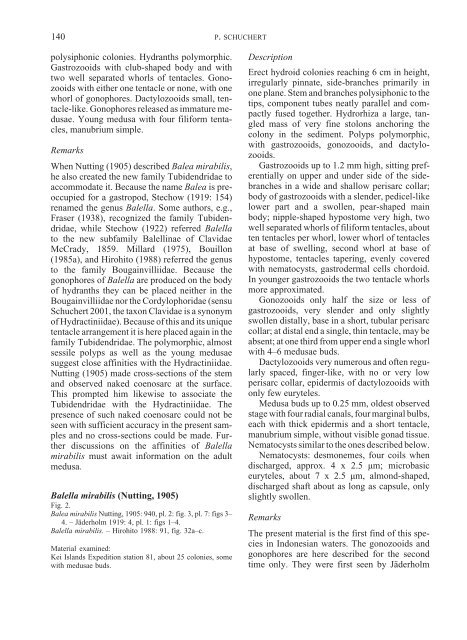Hydroids (Cnidaria, Hydrozoa) of the Danish expedition to
Hydroids (Cnidaria, Hydrozoa) of the Danish expedition to
Hydroids (Cnidaria, Hydrozoa) of the Danish expedition to
You also want an ePaper? Increase the reach of your titles
YUMPU automatically turns print PDFs into web optimized ePapers that Google loves.
140<br />
polysiphonic colonies. Hydranths polymorphic.<br />
Gastrozooids with club-shaped body and with<br />
two well separated whorls <strong>of</strong> tentacles. Gonozooids<br />
with ei<strong>the</strong>r one tentacle or none, with one<br />
whorl <strong>of</strong> gonophores. Dactylozooids small, tentacle-like.<br />
Gonophores released as immature medusae.<br />
Young medusa with four filiform tentacles,<br />
manubrium simple.<br />
Remarks<br />
When Nutting (1905) described Balea mirabilis,<br />
he also created <strong>the</strong> new family Tubidendridae <strong>to</strong><br />
accommodate it. Because <strong>the</strong> name Balea is preoccupied<br />
for a gastropod, Stechow (1919: 154)<br />
renamed <strong>the</strong> genus Balella. Some authors, e.g.,<br />
Fraser (1938), recognized <strong>the</strong> family Tubidendridae,<br />
while Stechow (1922) referred Balella<br />
<strong>to</strong> <strong>the</strong> new subfamily Balellinae <strong>of</strong> Clavidae<br />
McCrady, 1859. Millard (1975), Bouillon<br />
(1985a), and Hirohi<strong>to</strong> (1988) referred <strong>the</strong> genus<br />
<strong>to</strong> <strong>the</strong> family Bougainvilliidae. Because <strong>the</strong><br />
gonophores <strong>of</strong> Balella are produced on <strong>the</strong> body<br />
<strong>of</strong> hydranths <strong>the</strong>y can be placed nei<strong>the</strong>r in <strong>the</strong><br />
Bougainvilliidae nor <strong>the</strong> Cordylophoridae (sensu<br />
Schuchert 2001, <strong>the</strong> taxon Clavidae is a synonym<br />
<strong>of</strong> Hydractiniidae). Because <strong>of</strong> this and its unique<br />
tentacle arrangement it is here placed again in <strong>the</strong><br />
family Tubidendridae. The polymorphic, almost<br />
sessile polyps as well as <strong>the</strong> young medusae<br />
suggest close affinities with <strong>the</strong> Hydractiniidae.<br />
Nutting (1905) made cross-sections <strong>of</strong> <strong>the</strong> stem<br />
and observed naked coenosarc at <strong>the</strong> surface.<br />
This prompted him likewise <strong>to</strong> associate <strong>the</strong><br />
Tubidendridae with <strong>the</strong> Hydractiniidae. The<br />
presence <strong>of</strong> such naked coenosarc could not be<br />
seen with sufficient accuracy in <strong>the</strong> present samples<br />
and no cross-sections could be made. Fur<strong>the</strong>r<br />
discussions on <strong>the</strong> affinities <strong>of</strong> Balella<br />
mirabilis must await information on <strong>the</strong> adult<br />
medusa.<br />
Balella mirabilis (Nutting, 1905)<br />
Fig. 2.<br />
Balea mirabilis Nutting, 1905: 940, pl. 2: fig. 3, pl. 7: figs 3–<br />
4. – Jäderholm 1919: 4, pl. 1: figs 1–4.<br />
Balella mirabilis. – Hirohi<strong>to</strong> 1988: 91, fig. 32a–c.<br />
Material examined:<br />
Kei Islands Expedition station 81, about 25 colonies, some<br />
with medusae buds.<br />
P. SCHUCHERT<br />
Description<br />
Erect hydroid colonies reaching 6 cm in height,<br />
irregularly pinnate, side-branches primarily in<br />
one plane. Stem and branches polysiphonic <strong>to</strong> <strong>the</strong><br />
tips, component tubes neatly parallel and compactly<br />
fused <strong>to</strong>ge<strong>the</strong>r. Hydrorhiza a large, tangled<br />
mass <strong>of</strong> very fine s<strong>to</strong>lons anchoring <strong>the</strong><br />
colony in <strong>the</strong> sediment. Polyps polymorphic,<br />
with gastrozooids, gonozooids, and dactylozooids.<br />
Gastrozooids up <strong>to</strong> 1.2 mm high, sitting preferentially<br />
on upper and under side <strong>of</strong> <strong>the</strong> sidebranches<br />
in a wide and shallow perisarc collar;<br />
body <strong>of</strong> gastrozooids with a slender, pedicel-like<br />
lower part and a swollen, pear-shaped main<br />
body; nipple-shaped hypos<strong>to</strong>me very high, two<br />
well separated whorls <strong>of</strong> filiform tentacles, about<br />
ten tentacles per whorl, lower whorl <strong>of</strong> tentacles<br />
at base <strong>of</strong> swelling, second whorl at base <strong>of</strong><br />
hypos<strong>to</strong>me, tentacles tapering, evenly covered<br />
with nema<strong>to</strong>cysts, gastrodermal cells chordoid.<br />
In younger gastrozooids <strong>the</strong> two tentacle whorls<br />
more approximated.<br />
Gonozooids only half <strong>the</strong> size or less <strong>of</strong><br />
gastrozooids, very slender and only slightly<br />
swollen distally, base in a short, tubular perisarc<br />
collar; at distal end a single, thin tentacle, may be<br />
absent; at one third from upper end a single whorl<br />
with 4–6 medusae buds.<br />
Dactylozooids very numerous and <strong>of</strong>ten regularly<br />
spaced, finger-like, with no or very low<br />
perisarc collar, epidermis <strong>of</strong> dactylozooids with<br />
only few euryteles.<br />
Medusa buds up <strong>to</strong> 0.25 mm, oldest observed<br />
stage with four radial canals, four marginal bulbs,<br />
each with thick epidermis and a short tentacle,<br />
manubrium simple, without visible gonad tissue.<br />
Nema<strong>to</strong>cysts similar <strong>to</strong> <strong>the</strong> ones described below.<br />
Nema<strong>to</strong>cysts: desmonemes, four coils when<br />
discharged, approx. 4 x 2.5 µm; microbasic<br />
euryteles, about 7 x 2.5 µm, almond-shaped,<br />
discharged shaft about as long as capsule, only<br />
slightly swollen.<br />
Remarks<br />
The present material is <strong>the</strong> first find <strong>of</strong> this species<br />
in Indonesian waters. The gonozooids and<br />
gonophores are here described for <strong>the</strong> second<br />
time only. They were first seen by Jäderholm

















